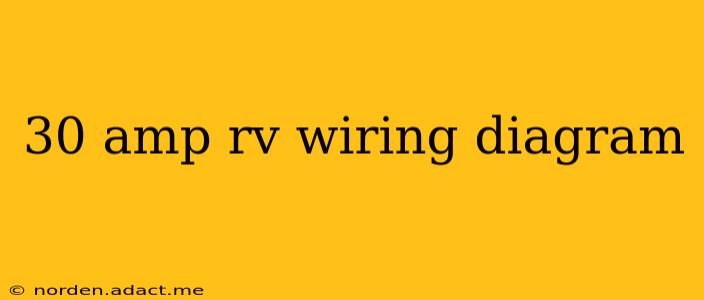Choosing the right wiring diagram for your RV's electrical system is crucial for safety and functionality. A 30-amp RV system is common, but understanding its intricacies is vital before undertaking any electrical work. This guide will walk you through the essentials of a 30-amp RV wiring diagram, explaining its components and addressing common questions.
Understanding the Basics of a 30-Amp RV Electrical System
A 30-amp RV system operates on 120-volt AC power, supplied through a 30-amp RV plug. This system is designed to power a range of appliances and accessories within your RV, including lights, air conditioning, refrigerators, and more. The 30-amp rating represents the maximum amount of current the system can safely handle. Exceeding this limit can lead to overheating, damage to your appliances, and potentially even fire hazards.
The system typically involves several key components:
- Shore Power Cable: The cable connecting your RV to a 30-amp power source at a campsite or RV park.
- RV Power Inlet: The receptacle on the outside of your RV where the shore power cable connects.
- Distribution Panel: This panel houses the breakers that protect individual circuits within your RV. Each breaker controls a specific appliance or group of appliances.
- Wiring Harness: The network of wires that connects the power inlet, distribution panel, and various appliances throughout the RV.
Key Considerations: Always ensure that your RV's electrical system is properly grounded to prevent electrical shocks. Consult a qualified electrician if you are unsure about any aspect of RV electrical work.
What are the different types of 30-amp RV plugs?
There are two main types of 30-amp RV plugs: the standard TT-30 and the less common twist-lock versions. The standard TT-30 is identified by its three blades, and it’s crucial to use the correct type of plug and receptacle for safe and proper operation of your RV's electrical system. Using an incorrect plug could cause damage or even a fire.
How many amps does a 30-amp RV circuit breaker use?
A 30-amp RV circuit breaker doesn't use amps itself. Instead, it protects the circuit from drawing more than 30 amps. If the current exceeds 30 amps, the breaker will trip, cutting off power to prevent damage and fire hazards. This is a critical safety feature of your RV's electrical system.
What gauge wire is used in a 30-amp RV system?
The appropriate gauge wire for a 30-amp RV system is typically 10-gauge wire. Using a smaller gauge wire will increase resistance, leading to heat buildup and potential damage. Using a larger gauge wire isn't necessary and might unnecessarily increase costs. Always check your RV's manufacturer specifications to confirm the recommended wire gauge for your specific model.
Can I use a 30-amp RV on a 50-amp hookup?
Yes, you can use a 30-amp RV on a 50-amp hookup. However, you'll need an adapter, and you won't be able to utilize the full capacity of the 50-amp service. This is perfectly safe as long as your RV's electrical system is appropriately protected by the 30-amp breakers within the RV.
How to properly wire a 30-amp RV system?
Wiring a 30-amp RV system is a complex undertaking. This is not a DIY project for most people. Improper wiring can lead to significant safety hazards. If you're not an experienced electrician familiar with RV electrical systems, it’s strongly recommended to consult a qualified professional. Incorrect wiring could lead to overheating, electrical fires, and damage to your appliances.
Troubleshooting a 30-Amp RV Wiring System
If you encounter problems with your 30-amp RV electrical system, start by checking the following:
- Power Source: Ensure the power source at the campsite is functioning correctly.
- Breaker Panel: Check the breakers in your RV's distribution panel to see if any have tripped. Reset them only if necessary and after identifying why the breaker tripped.
- Connections: Inspect all connections, both inside and outside the RV, for loose wires or corrosion.
- Appliances: Test individual appliances to determine if the issue is localized to a specific appliance or affects the entire system.
If you cannot identify the problem, contact a qualified RV technician. Attempting to troubleshoot complex electrical issues without the proper knowledge can be dangerous.
This comprehensive guide provides a solid foundation for understanding 30-amp RV wiring diagrams. Remember, safety should always be your top priority when dealing with electricity. If you have any doubts or lack experience, consult a professional.
